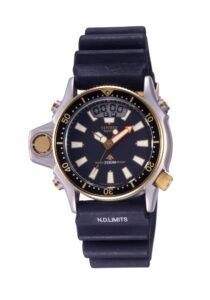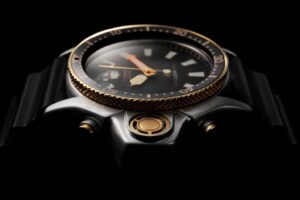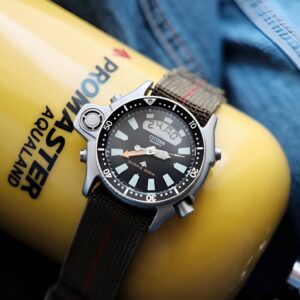
The Legacy of Traditional Dive Watches in the Age of Technology
Diving watches maintain a cherished niche despite the many modern technologies, such as diving computers and smartwatches, that have appeared in the watchmaking landscape. These high-tech gadgets, while packed with features, have yet to outshine the enduring appeal of mechanical dive watches. Indeed, in many ways, today’s diving watches are actually in possession of more dive-ready qualities than their ancestors of the 1950s. Back then, the underwater watch was represented by two distinct forms: the iconic Rolex Submariner and the slightly less well-known—but also iconic—Blancpain Fifty Fathoms.
Yet modern diving tools are tested against these classic timepieces. Diver’s watches are relevant and are well-exemplified by Citizen’s Aqualand, which has been around for 40 years. The Aqualand diver’s watch, introduced in 1985, was more than just a simple timekeeping device. It was the first watch to combine the reliable quartz timekeeping with an electronic digital depth gauge. This was a pivotal moment in the history of diver’s watches. If you look at and think about an Aqualand watch, or the earlier Aqualand models, you have to recognize that they are doing something very special with the way they bring together mechanics, electronics, and the very nature of diving itself.
For more information, check out Citizen Aqualand: Birth of a Legend, End of an Era.
The Rise of SCUBA Diving and the Role of Dive Watches
The advancement of SCUBA, which is defined by the self-contained underwater breathing apparatus, changed profoundly how divers were able to explore underwater. The Aqua-Lung, which was created by Jacques Cousteau and Émile Gagnan in the 1940s, was a direct forerunner to modern SCUBA gear and was the result of a collaborative effort. The Aqua-Lung made underwater exploration much less ‘adventurous’ in a dangerous sense and much more accessible, including to the types of people who had the specialized skills to make and use wrist instruments that could tell time reliably under the extreme conditions found underwater.
In the 1950s, it became necessary to have a watching device that could accurately keep track of the two vital factors needed for safe diving—air consumption and dive time—at the sorts of recreational depths (40 meters) that people started pushing for. But today’s divers go much deeper (332.35 meters, in 2014, with 13 hours of required decompression afterward) and push the limits even farther with staged and mixed-gas dives. When they talk about needing a watch to “dive,” to track them at the sort of pressures and for the sorts of time-related calculations that real ocean-going subs have to cope with.
Specialized tools, like the depth gauge, are a direct result of the underwater demands of pressure and air supply management. For any serious diver, a depth gauge is an essential instrument. The Citizen Aqualand took this must-have tool and gave it a practical solution to an age-old problem by combining it with a reliable quartz dive watch and what was then state-of-the-art counting technology. With the Aqualand, divers had no reason not to manage both their depth and their time underwater. One compact instrument did both jobs.

The Game-Changing Role of the Citizen Aqualand Depth Gauge
Prior to 1985, the bulk of underwater explorers depended on old-fashioned depth gauges and dive watches, which were typically worn in tandem. By integrating an electronic depth gauge with an analog quartz watch, the Citizen Aqualand redefined the dive watch. Usability and convenience were increased with this real-time depth-reading, timing function powerhouse.
The depth gauge, which could measure depths to 80 meters with a 3% deviation, was powered by a water pressure sensor. But Aqualand didn’t stop there. It featured a digital display that not only tracked depths in real-time but also logged dive data for later review. This allowed divers to monitor their air consumption and ensure they adhered to no-decompression limits, a critical safety feature.
Before the Aqualand, various timepieces, such as the mechanical models from Favre-Leuba and Nivada, had problems with precision and demanded intricate, unremitting attention. The Aqualand, in contrast, was an instrument of reliable performance. With only minimal upkeep required, it suited not just diving aficionados, but also a growing legion of behaviorally diverse professional divers. More than a timepiece, it was a diving watch completely designed with divers in mind.
How the Aqualand Helped Divers Plan Safer Dives
Diving has always involved intrinsic hazards, but the Aqualand’s unveiling of the digital depth gauge has helped reduce these risks. Depth gauges like those on the Aqualand allowed divers to track their depth and time with much more accuracy than human judgment alone. Gauges like these made it possible to plan dives that stayed well within the limits of safety defined by the most current science on the human body’s absorption of nitrogen at various pressures. Of course, being able to see one’s depth was only part of the equation; the Aqualand also had to remind the diver of the maximum no-decompression limit (NDL) at a given depth.
These features made the Aqualand much more than a mere timekeeping device; it had become a crucially important safety instrument for divers. Simplifying the dive plan and providing otherwise hard-to-gather data made the Aqualand a virtual survival tool. It allowed for easier calculations and reading of essential parts of the dive plan—a calculation, in itself, that is to be done using a dive table or dive computer. If anything, it proved to some in the diving community that using a watch during a dive was still a viable option. It was able to be all of this while still being an evolution of the very idea of a dive watch. Safety and readability may be two of things that keep it unevolved, but those two attributes are also why it remains such a tethered concept.
For more information, read The History of The Citizen Aqualand, The Icon Celebrating 40 Years.
Continuing Evolution: Citizen Aqualand Through the Years
From the initial Aqualand in 1985, the watch has gone through many revisions, each augmenting its capabilities without compromising the unmistakable form that is a Casio watch. A big step forward functionally came with the Calibre C520, introduced in 1992, which reduced the power supply from three batteries to a single battery. This improved efficiency and allowed for greater energy use in new features, like keeping track of four dive logs instead of one.
Even with the increase in popularity of dive computers, the Aqualand has maintained its place in the hearts of divers for its unusual melding of traditional analog watchmaking with modern digital technology. While its features have been compacted in recent models, the design of the Aqualand has not changed all that much over the years—a not-so-sudden, not-so-unhappy evolution that offers a persistent aesthetic appeal to divers of all persuasions.
The Promaster Aqualand JP2000 on offer right now is a current model. It is the latest in a long line. It offers mostly the same functionalities as its forebears but has received some welcome modern updates. The watch now has dual LCD screens, for instance, to display time and depth. When you look at the price point, under $400, you can’t help but consider it an affordable and effective tool for divers. At that price, you get the same reliability functions that the Aqualand pioneered over 30 years ago.

The Citizen Aqualand: An Affordable Icon
Perhaps the most remarkable thing about the Citizen Aqualand is how accessible it is. While dive watches from high-end luxury brands such as Rolex or Blancpain can cost several thousands of dollars, the Aqualand has consistently been a reasonably priced alternative—often coming in under $400 for new models. And yet, despite this affordability, the Aqualand remains an iconic piece of dive watch history, offering reliability, durability, and precision that would make even the most jaded watch snob take a second look.
The ongoing success of the Aqualand can be traced back to its simple yet effective design and low-cost price. While it may not ooze the same kind of luxury as its higher-end counterparts, it gives you everything you need for a fun, worry-free diving experience. If you want a watch that won’t let you down and also won’t knock you out after you buy it, the Citizen Aqualand is the hands-down recommendation.
Frequently Asked Questions (FAQ)
- What makes the Citizen Aqualand stand out from other dive watches?
The Citizen Aqualand stands out due to its unique integration of an electronic digital depth gauge with an analogue quartz watch. This allows divers to track depth and time simultaneously, which was a significant innovation when it was first introduced in 1985. Unlike traditional dive watches that require separate depth gauges, the Aqualand provides all the necessary information in one compact and reliable timepiece. - Is the Citizen Aqualand suitable for professional divers?
The Citizen Aqualand is suitable for both recreational and professional divers, as it was designed to meet their needs. It possesses several standard features that are essential for safe and effective underwater exploration, which include a depth gauge, no-decompression limits, and a digital chronograph. Needing to surpass the mere look of an appealing diving watch, the watch is safe to say that it is built for divers. It is water-resistant to depths of 200 meters, meaning that it is far more capable than many diving situations require. - How precise is the depth gauge on the Aqualand?
The depth gauge on the Citizen Aqualand is completely precise, with a maximally allowable deviation of just 3%. It can indicate depths down to 80 meters and gives real-time readings, so it’s a good tool for divers to use. Also, the watch stores logs of when the user has dived, allowing for easy reference to not only the times and dates of past dives but also the planning of future excursions. - Over the years, how has the Aqualand improved?
The Aqualand has seen a few updates since making its first splash in 1985. The largest of these was in 1992 and it saw the watch transition from a three-battery system to a single, more efficient battery. Almost simultaneously, the Calibre C520 became the standard movement in the Aqualand with a few updates that allowed for better memory performance. Following the cleaner interface that the C520 allowed for, a series of visual improvements made their way into the Aqualand, leaving us with the watch that now sits on our wrists. The Promaster Aqualand JP2000, the most current incarnation of the Aqualand, is available to the public with dual LCD screens. Grinning widely at you from beneath the polished bubble that encases the mineral crystal are the Aqualand’s now-rather-modern features.